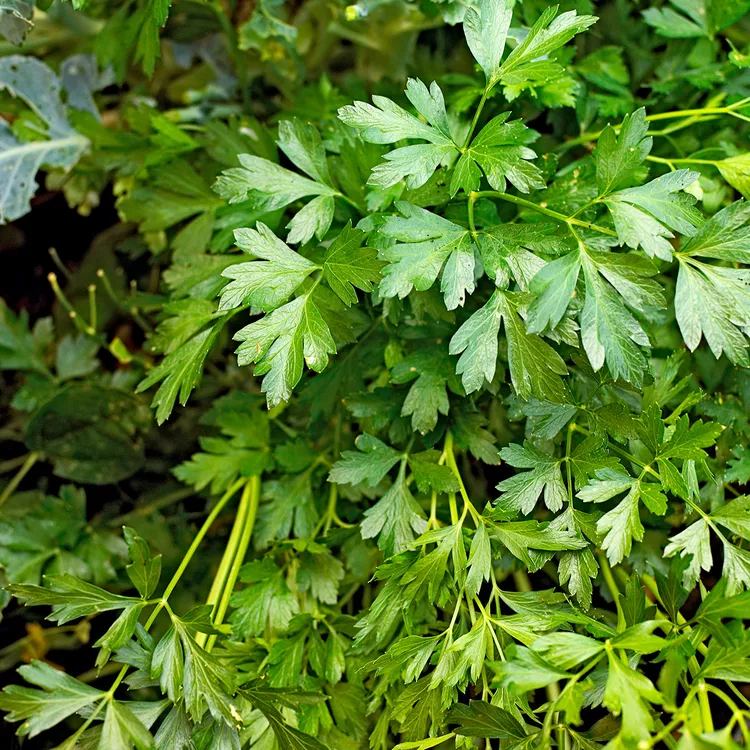10 Best Parsley Companion Plants to Grow Together

Parsley is a cut-and-come-again, biennial herb that can be harvested throughout the growing season. To use parsley as a companion plant for natural pest control, grow extra parsley plants and allow them to flower. Parsley flowers attract beneficial insects, such as parasitic wasps, that feed on common garden pests. In this guide, you’ll find some of the best parsley companion plants and some simple companion planting tips to maximize your harvest.
Brassicas
Cauliflower, cabbage, and other brassicas are staples in vegetable gardens, but these plants are some of the most vulnerable crops when it comes to pests. However, if you grow flowering parsley plants among the brassicas, the parsley attracts beneficial insects that feed on cutworms, cabbage loopers, and other brassica pests.
Corn
If you’ve ever grown corn in your garden, you know that many pests are attracted to this fresh treat. Cutworms, earworms, and armyworms can wriggle their way through corn husks and gnaw into kernels before you get a chance to pick the ears. Parsley flowers attract the predatory insects that feed on corn pests, helping to protect your crop.
Tomatoes
Parsley can help safeguard tomatoes from aphids. The flowers of parsley plants attract hoverflies that feed on these pests. Parsley can also be used as a trap crop to lure aphids away from more vulnerable vegetables such a your prize tomatoes.
Roses
Roses are beloved plants in flower gardens, but they are prone to an assortment of pests, such as sawflies, aphids, and rose beetles. Growing parsley near roses may seem an odd choice, but parsley’s fragrance repels rose pests and attracts predatory insects. For even more perks, try using a few parsley flowers as alternatives to baby’s breath in your homemade rose bouquets.
Pear Trees
Pear trees add beauty and color to gardens, and they can produce a prolific harvest of juicy pears in late summer to autumn. However, pear trees are susceptible to various pests, including codling moths and spongy moths. Both of these pests can be kept at bay by braconid wasps, which are attracted to parsley flowers.
Chives
Most tender-stemmed herbs grow well with parsley, and chives are no exception. Chives and parsley have similar growing needs, which makes them easy to grow side by side in pots or garden beds. Plus, parsley flowers repel certain chive pests, including the onion maggot.
Asparagus
Asparagus takes a few years to produce edible spears and occupies valuable garden space in the meantime. However, if you grow parsley between the asparagus rows, you make smart use of empty garden space and boost the productivity of the garden. On top of that, parsley and asparagus plants enhance each other’s growth, and parsley can repel asparagus beetles.
Beans and Peas
Beans and peas have the ability to add nitrogen from the air to the soil, boosting the growth of nearby plants. Growing legumes near parsley (and many other herbs) can result in the herbs producing more luscious leaves for your favorite recipes. Parsley flowers also attract tachinid flies, which feed on legume pests, including cutworms.
Peppers
Peppers are vulnerable to many of the same pests as corn and tomatoes, but if you keep parsley near your peppers, it helps shield chilis and bell peppers from armyworms, aphids, and earworms. As a bonus, if you run out of homegrown cilantro, you can use parsley leaves as an alternative in homemade salsas.
Apple Trees
Like pear trees, apple trees are sometimes targeted by spongy moths and codling moths that bore holes in fruit and defoliate trees. Growing parsley near apple trees keeps these pest insects away and protects the apples for the harvest ahead. Try planting a ring of parsley around the trunks of apple trees, or grow a few parsley plants in pots and move them beneath the trees when the parsley starts flowering.